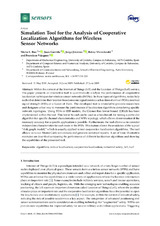Simulation Tool for the Analysis of Cooperative Localization Algorithms for Wireless Sensor Networks

View/
Author
Ruz Ruiz, Mario L.
Garrido, J.
Jiménez Hornero, Jorge
Virrankoski, Reino
Vázquez Serrano, Francisco J.
Publisher
MDPIDate
2019Subject
AlgorithmsIndoor localization
Cooperative localization
Industrial safety
IoT
LoT
METS:
Mostrar el registro METSPREMIS:
Mostrar el registro PREMISMetadata
Show full item recordAbstract
Within the context of the Internet of Things (IoT) and the Location of Things (LoT) service,
this paper presents an interactive tool to quantitatively analyze the performance of cooperative
localization techniques for wireless sensor networks (WSNs). In these types of algorithms, nodes help
each other determine their location based on some signal metrics such as time of arrival (TOA), received
signal strength (RSS), or a fusion of them. The developed tool is intended to provide researchers
and designers a fast way to measure the performance of localization algorithms considering specific
network topologies. Using TOA or RSS models, the Crámer-Rao lower bound (CRLB) has been
implemented within the tool. This lower bound can be used as a benchmark for testing a particular
algorithm for specific channel characteristics and WSN topology, which allows determination if the
necessary accuracy for a specific application is possible. Furthermore, the tool allows us to consider
independent characteristics for each node in the WSN. This feature allows the avoidance of the typical
“disk graph model,” which is usually applied to test cooperative localization algorithms. The tool
allows us to run Monte-Carlo simulations and generate statistical reports. A set of basic illustrative
examples are described comparing the performance of di erent localization algorithms and showing
the capabilities of the presented tool
